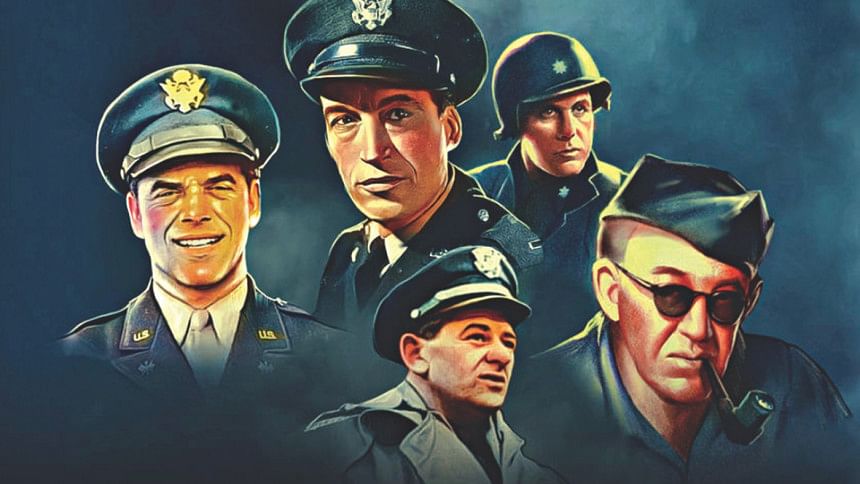Five Came Back: when Hollywood went to war

When browsing through the catalogue of shows on Netflix one night, I came across an entry with a thumbnail that took me back to the book covers of classic thriller novels such as Alastair McLean’s Guns of Navarone. The title was intriguing, as was the trailer—Five Came Back takes a look at five Oscar-winning directors and their work during World War II, with narration from Meryl Streep and analysis by Steven Spielberg, Francis Ford Coppola, Guillermo Del Toro, Paul Greengrass and Lawrence Kasdan.
The five directors whose work is put under the microscope—Frank Capra (of It’s a Wonderful Life fame), William Wyler (Wuthering Heights, Roman Holiday and Ben Hur), John Ford (Grapes of Wrath, Rio Grande), John Huston (The Maltese Falcon, The Treasure of Sierra Madre) and George Stevens (The Diary of Anne Frank) all have similar beginnings of fame and adulation, but diverge in their paths while covering the war.
The story starts with the tension surrounding America’s involvement in the war in Europe. Cut off from the conflict, pre-war America is at odds with its present-day politics and is shown as hesitant to engage in the fight. The government employed Hollywood’s best and brightest to produce ten-minute shorts on the conflict raging in Europe, played before film screenings in theaters. They would go on to be full-length documentaries, the first of their kind.
By then, the American movie industry was worth millions, and would eventually offer up the services of Frank Capra—an Italian immigrant filled with existentialist questions and the desire to prove himself. Tasked by the War Department to make the shorts at a time when America was not at war and with no way of gathering footage, Capra used Nazi propaganda footage to show Americans the grand posturing of the Nazi rank and file, not to mention Hitler’s hate-filled speeches. In his work, he would often introduce the enemy to moviegoers, including the ironically racist and counterintuitive Japanese in Know Your Enemy – Japan (1945), which would play a role in the internment of Japanese immigrants on America’s West Coast.
John Ford, hot on the trails of the five Oscar wins for How Green Was My Valley (1941), would go on to serve as the head of Field Photo, a special unit comprising cameramen and directors that captured invaluable footage of the war for the US Navy. His coverage of the war in the Pacific in The Battle of Midway (1942) would be considered a turning point for war documentaries, with the natural camera shake and in the zone filming winning critical acclaim for relaying the tension of battle to audiences that had never been in war. By landing on the beaches during D-day, John Ford took footage of extraordinary violence, the likes of which were suppressed by the War Department as they were convinced it would create an anti-war sentiment back home.
William Wyler, a director of Jewish descent from Mulhouse, France, would tour with the crew of a B17 bomber, the Memphis Belle, and would capture reel after reel of film showing the horrors of death from the air. But his biggest contributions would never see the light of day carrying his own credit: the depiction of African American soldiers in a segregated America, their treatment at the hands of white servicemen, the routine racism from commanding officers, as well as the threat of the KKK. In the end, Wyler’s films would be constrained by the War Department itself, which would give guidelines for “how to depict the Negro soldier”.
Later, Wyler’s project would see the light of day as The Negro Soldier (1944) with screenplay by Carlton Moss, an African American serviceman who was attached to Wyler.
John Huston, of British descent, would tour Italy with American units. His film of American soldiers and the aftermath of The Battle for San Pietro (1945)—the ‘cleanup’, as it were, with footage of piled up bodies and grave digging—would offend generals and army men to the point where they would refuse to release his films. Only General George C. Marshall’s intervention would make it available to fresh recruits and the public, so that they could know the true price of war. After the war, he would film Let There Be Light—a look into the permanent scarring of war and the rehabilitation of servicemen from battle fatigue. It was the first look at PTSD, before the term was even invented. It would be seized and restricted from viewing by the War Department, not to be shown till the 1980s.
And towards the tail end of the war in Europe, George Stevens would stumble upon the biggest secret of the Nazi occupation of Europe—the horror of Dachau concentration camp in the aftermath of the Battle of the Bulge. He saw the gas chambers, the furnaces, the survivors, and filmed it all. The footage of these death factories served as proof in the Nuremberg trials.
For someone who only had access, as a child, to the often biased and largely one-dimensional historical documentaries peddled by the likes of History Channel and Discovery, it was a sobering realisation for me later on in life that few of these films had any real substance beyond a basic presentation of facts. Five Came Back, unlike these predecessors, offers a rare in-depth look at conflict, both outside and within the people telling stories of that conflict, as opposed to the pure propaganda that they set out to create. We see the grey—how the evil and the righteous are not as distinctly different as we think. And we see the legacy left behind by these directors, such as with Steven Spielberg and Schindler’s List and Francis Ford Coppola and Apocalypse Now.

 For all latest news, follow The Daily Star's Google News channel.
For all latest news, follow The Daily Star's Google News channel. 



Comments